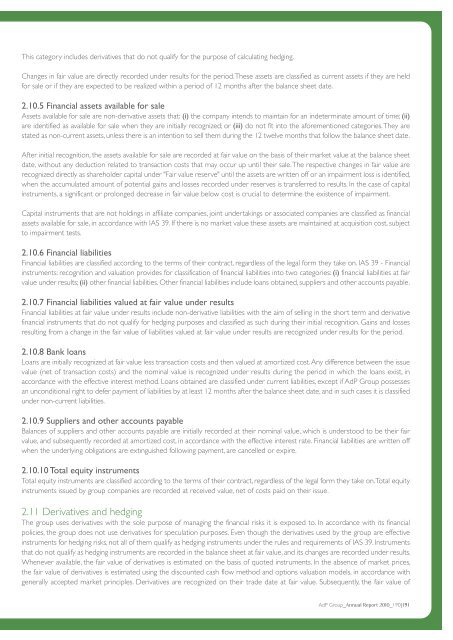Annual Report 2010 - AdP
Annual Report 2010 - AdP
Annual Report 2010 - AdP
You also want an ePaper? Increase the reach of your titles
YUMPU automatically turns print PDFs into web optimized ePapers that Google loves.
This category includes derivatives that do not qualify for the purpose of calculating hedging.<br />
Changes in fair value are directly recorded under results for the period. These assets are classified as current assets if they are held<br />
for sale or if they are expected to be realized within a period of 12 months after the balance sheet date.<br />
2.10.5 Financial assets available for sale<br />
Assets available for sale are non-derivative assets that: (i) the company intends to maintain for an indeterminate amount of time; (ii)<br />
are identified as available for sale when they are initially recognized; or (iii) do not fit into the aforementioned categories. They are<br />
stated as non-current assets, unless there is an intention to sell them during the 12 twelve months that follow the balance sheet date.<br />
After initial recognition, the assets available for sale are recorded at fair value on the basis of their market value at the balance sheet<br />
date, without any deduction related to transaction costs that may occur up until their sale. The respective changes in fair value are<br />
recognized directly as shareholder capital under "Fair value reserve" until the assets are written off or an impairment loss is identified,<br />
when the accumulated amount of potential gains and losses recorded under reserves is transferred to results. In the case of capital<br />
instruments, a significant or prolonged decrease in fair value below cost is crucial to determine the existence of impairment.<br />
Capital instruments that are not holdings in affiliate companies, joint undertakings or associated companies are classified as financial<br />
assets available for sale, in accordance with IAS 39. If there is no market value these assets are maintained at acquisition cost, subject<br />
to impairment tests.<br />
2.10.6 Financial liabilities<br />
Financial liabilities are classified according to the terms of their contract, regardless of the legal form they take on. IAS 39 - Financial<br />
instruments: recognition and valuation provides for classification of financial liabilities into two categories: (i) financial liabilities at fair<br />
value under results; (ii) other financial liabilities. Other financial liabilities include loans obtained, suppliers and other accounts payable.<br />
2.10.7 Financial liabilities valued at fair value under results<br />
Financial liabilities at fair value under results include non-derivative liabilities with the aim of selling in the short term and derivative<br />
financial instruments that do not qualify for hedging purposes and classified as such during their initial recognition. Gains and losses<br />
resulting from a change in the fair value of liabilities valued at fair value under results are recognized under results for the period.<br />
2.10.8 Bank loans<br />
Loans are initially recognized at fair value less transaction costs and then valued at amortized cost. Any difference between the issue<br />
value (net of transaction costs) and the nominal value is recognized under results during the period in which the loans exist, in<br />
accordance with the effective interest method. Loans obtained are classified under current liabilities, except if <strong>AdP</strong> Group possesses<br />
an unconditional right to defer payment of liabilities by at least 12 months after the balance sheet date, and in such cases it is classified<br />
under non-current liabilities.<br />
2.10.9 Suppliers and other accounts payable<br />
Balances of suppliers and other accounts payable are initially recorded at their nominal value, which is understood to be their fair<br />
value, and subsequently recorded at amortized cost, in accordance with the effective interest rate. Financial liabilities are written off<br />
when the underlying obligations are extinguished following payment, are cancelled or expire.<br />
2.10.10 Total equity instruments<br />
Total equity instruments are classified according to the terms of their contract, regardless of the legal form they take on. Total equity<br />
instruments issued by group companies are recorded at received value, net of costs paid on their issue.<br />
2.11 Derivatives and hedging<br />
The group uses derivatives with the sole purpose of managing the financial risks it is exposed to. In accordance with its financial<br />
policies, the group does not use derivatives for speculation purposes. Even though the derivatives used by the group are effective<br />
instruments for hedging risks, not all of them qualify as hedging instruments under the rules and requirements of IAS 39. Instruments<br />
that do not qualify as hedging instruments are recorded in the balance sheet at fair value, and its changes are recorded under results.<br />
Whenever available, the fair value of derivatives is estimated on the basis of quoted instruments. In the absence of market prices,<br />
the fair value of derivatives is estimated using the discounted cash flow method and options valuation models, in accordance with<br />
generally accepted market principles. Derivatives are recognized on their trade date at fair value. Subsequently, the fair value of<br />
<strong>AdP</strong> Group_<strong>Annual</strong> <strong>Report</strong> <strong>2010</strong>_190|191


